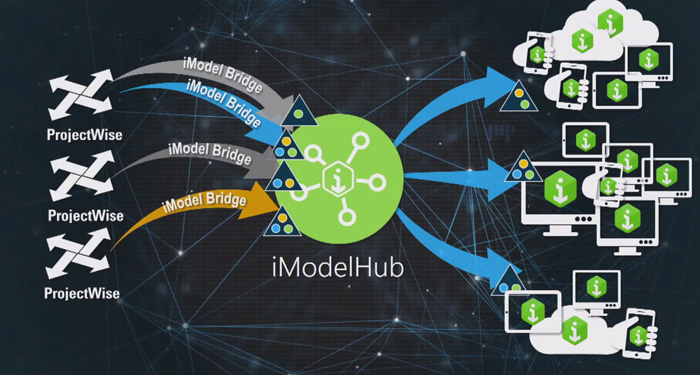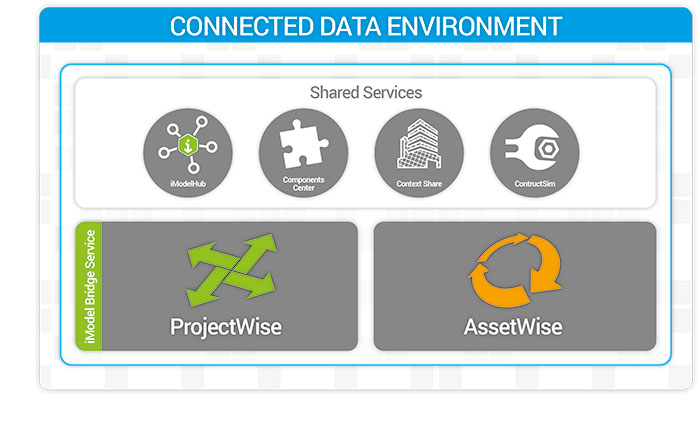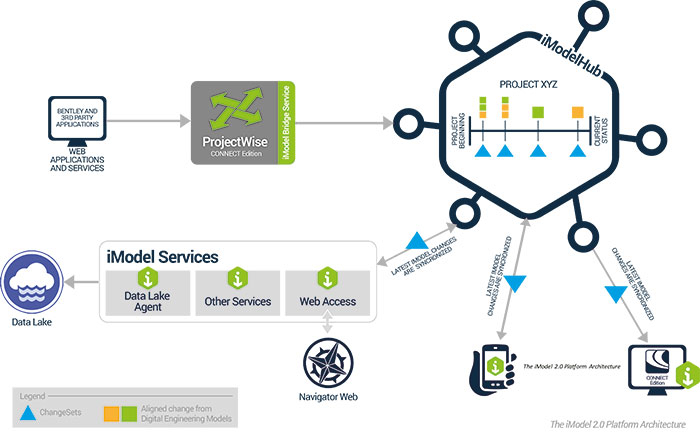At the Year In Infrastructure event, held in Singapore in October, Bentley Systems CTO Keith Bentley unveiled the company’s most significant technology update in a decade, writes Martyn Day
Ten years ago, Bentley Systems introduced iModels as a format to exchange information between design, construction and operations environments. As a bespoke format, it was designed to hold information pertinent to the construction industry, supporting business properties, geometry, graphics and relationships.
These optimised files are self-defining; in other words, they don’t require a CAD system to view precise model geometry (there is a free viewing application Bentley View on mobile or desktop), they know their source and when they were produced and can conform to multiple schemas, supporting industry standards. Companies such as Trimble embraced the format and plug-ins were developed for popular products such as Tekla Structures, ArchiCAD, Rhino, AutoCAD and SketchUp.
As the software industry moves to the cloud, Bentley continues to harmonise the data structures of its multitude of products within the DGN format. While DGN is still the most stable and consistent format in the industry, internally developed Bentley applications and acquired technology do not necessarily store data in the identical structures within DGN. This can become an issue as Bentley’s product stack accelerates to enable seamless digital workflows between all its products on its common MicroStation platform.
With that in mind, the company has taken a fresh look at the iModel format, its capabilities and how it can homogenise its own internal data structures to deliver unparalleled digital workflows and apply multi-disciplinary analysis and machine learning to consistent project data.
At Bentley Systems’ Year in Infrastructure event, held in Singapore in October, Keith Bentley, the company’s CTO and chief software architect, explained in his keynote presentation the reasons behind this development and why he believes the benefits will make the new technology a game-changer for distributed project teams.

Digital workflows
Despite CAD, document management systems, the internet, the cloud and BIM, the industry hasn’t really travelled very far in the last twenty years. We still buy large format printers and the industry has adopted PDF as a digital replication of the printing substitute. But just because a PDF is electronic it doesn’t mean that it provides a much better alternative to older workflows. Much time is spent creating data-rich models and then flattening them out into a format that can be emailed. That just adds to a noise of files that muddies the waters when it comes to team-wide understanding.
To build a format fit for the cloud generation, Keith Bentley and his team have come up with a way to share data with seamless elegance.
Keith Bentley first started his presentation by talking about what the cloud is – and what it is not. Many people think of the cloud as a large supercomputer with infinite resources, that can solve any problem instantly. While you might be able to buy a machine like this, the cloud isn’t actually one big computer, but lots of smaller computers running multiple applications. In fact, most applications running
in the cloud use similar resources to those written for a single personal computer. In the days before personal computers, there was typically one computer for many humans. When the personal computer arrived, the ratio changed to one to one. This was progress. However, in the cloud world, the ratio changes again, to many computers per user, and this is where the greatest opportunity lies. So, when Keith Bentley talks about cloud platforms and cloud services, there can be many programs and services running all at the same time and that can be of real value to users.
Historically, iModels were a way to collate large sets of project data into a single file or container. You could practically put anything you wanted into an iModel. While that has worked out pretty well for users, Bentley feels it can improve on that, and specifically, provide more convenience and closer collaboration than PDFs provide today.
In coming up with iModel 2.0, Keith Bentley explained that there were three issues in iModel 1.0 that needed to be resolved in order to leverage the cloud.
Issue 1: dark data
The first is a concept that Bentley calls ‘dark data’. With many projects, there is a lot of this. It’s information that is rarely used and only understood by the applications that created it, because intelligence and data are separated.
According to Bentley, the real problem here is that data considered to be dark is stored in a format by the application that created it, developed by a programmer who was thinking only about one job in particular. The data needs to be saved out to disk, so that a user can read it back in the next session. Bentley equates this to that data being stored on a disk through a ‘filter’ that only the programmer knows or understands.
Another file on the same disk from a different programme will be written by a different programmer who stored their own data in a slightly different way. With different angles of filters running across a large project, you could have six or seven – or even a dozen – different applications. In other words, when you put all those filters together, that’s why data is dark. It’s a tangled mess.
For iModel 2.0, Keith Bentley says the company has undertaken the alignment of this dark data. Alignment involves lining up units, deciding whether distances are stored in metres or feet, whether temperatures are in Fahrenheit or Centigrade, and angles in radians or degrees. By aligning data, it becomes digestible and can be shared and used as an input for many other systems, such as machine learning.
This is not a pretty problem, Keith Bentley acknowledged, but it’s real and the company knew it needed to realign its data before it could be repurposed for digital workflows.
Issue 2: making changes
The second issue is another common problem that occurs when someone creates an iModel from a number of disparate files and another person updates one of those source files. This requires a re-run to make a new iModel. That’s a lot of work, especially if the second iModel is 97.7 percent the same as the original. Keith Bentley describes this limitation as “insane”. Change is the lifeblood of projects, and iModel needed to be more change-tolerant. The net result of this thinking has been to store changes, rather than the results of changes, as per the previous file-based methodology.
Changes, of course, happen in sequence. A person changes one thing, a subsequent team member then changes something else. Bentley Systems has addressed this by coming up with a cloud service it calls iModelHubs. This is a single, centralised hub where changes to iModels are reliably and securely stored and time stamped. According to Keith Bentley, it’s a bit like the bank statement you receive every month, with a start date and an end date, and the balances for those days. The list of transactions in between show how you got from opening to closing balance.
So, in effect, iModelHub is an accounting system for projects. You can see from the list what happened at any point in time in a project. You create an iModel 2.0 at the start and the iModelHub will synchronise it forwards or backwards to get to any point in time in the project’s duration. Some points on the timeline will be milestones and these can be named. It’ll give an indication, for example, of when approvals, reviews or submittals occurred. One important aspect of this is that you can’t go back and revise history – so if you remember a point on the timeline in your iModelHub, you can always be guaranteed if you go back to that point, you’ll get the exact same version of the iModel.

Issue 3: accessibility
The third and final issue Bentley addressed is accessibility. If iModelHub stores only the changes to an iModel, where’s the master iModel, you might wonder? The answer is that there is no master iModel. Instead, there are lots of copies of the iModel and they are all synchronised through iModelHub with changes. Each one of these iModels is as reliable as the next as they are derived from the same recipe of changes. The master copy, in fact, is the timeline itself.
As iModels are files, they can be stored on disk, but need to be synchronised to iModelHub to stay up-to-date. However, you don’t need to connect to the iModelHub in order to perform any operation on an iModel. Should you have an iModel on your iPad, for example, it doesn’t need connectivity to iModelHub to still be of value. It only needs connection to iModelHub to change its point on the timeline. When iModels are stored on the cloud, they can be connected to services such as tools for analysis, quantity surveying, or facilities/asset management. These can be used by many individuals, for many different applications, simultaneously. This is exceptionally liberating for CAD data.

iModel bridges
So how can firms start using this technology? Bentley explained a concept that the company calls iModel Bridges. These iModel Bridges connect to ProjectWise, so ProjectWise customers just need to install an iModelBridge for every application or format that they want to map into their iModels. The bridge runs automatically when anybody checks a change into ProjectWise and it marks the change in the iModelHub, too, which in turn updates the iModel 2.0 files. Users have no idea this is happening, as it’s all done behind the scenes. Bentley explained that the development team has been working on iModel 2.0 for a long time, but now believes it will change Bentley’s business and help customers change their own businesses, too, by adopting and benefiting from digital workflows. By embracing change, change becomes a first-class citizen in project ecosystems.
With a change-based system, it’s also easier to keep track of changes on a project from data edited across multiple applications. Notifications can be sent when something important changes, allocation of changes and responsibility for changes become more identifiable. In some ways, and to carry on the banking analogy, the system can alert you when changes are made, similar to when the bank notifies you that your credit card has been used in a different country.
iModels also feature a timeline slider, so you can see what changed in a model through its lifecycle – red denotes deleted, green denotes additions and blue denotes modifications. Users can also spot areas where there have been many changes, identifying design problems via ‘a heat map’ that provides an indication of issues that may delay a project or that have proved contentious. The system is also not limited to geometry, but highlights property changes too.
Bentley hopes that machine learning will be used to analyse project changes, so that successes and failures can be identified and carried forwards into subsequent projects, as a lesson to designers based on their past errors.
With iModel 2.0, iModelHub and iModel Bridges, Bentley has come up with a unique solution to project management using the cloud. Keith Bentley was asked about what other firms were doing to solve this, and said that other solutions focus on a centralised database with other applications reading and writing directly to it. This approach, he said, addresses the issue with alignment, because you are not really able to use any other data, but doesn’t embrace change at all, and can become a bottleneck with little scalability. And, at the end of a project, a massive database gets handed over, which the customer has to adopt. With iModel 2.0, the client simply takes over the timeline for the lifecycle of the building.
Conclusion
While on the face of it, iModel 2.0 may sound complicated, with its hubs and its bridges, it is underpinned by some very elegant thinking when it comes to cracking the problems that BIM designers and engineers face with today’s project workflows. It collates data from multiple packages from different vendors, keeps data from going dark, enhances portability and accessibility, tracks changes, helps identify problem areas in design, 2D sections and elevations, drives collaboration and frees CAD data for others to use.
The notion of a single massive centralised database on the cloud may have seemed like an inevitability, but Bentley has taken a more revolutionary view, by boiling down what is important and how this can be driven using the cloud, in what is almost a blockchain approach. The company’s decision to focus on change and to distribute rich content in a managed and secure environment has great potential to also overcome some of the industry’s most painful BIM collaboration problems.
Similarly, PDFs may be the industry standard format, but they just replicate old processes and offer little more than dull digital prints. With version 2.0, iModels come alive, to be fed by traditional project management tools. They can be taken offline and re-synchronised later, while still offering a deep insight not only on the current state of a project but also into the ‘who, why and what’ of changes. Milestones are stored in the file, which means no more transfer of files and no more mushrooming file management issues across project teams.

I’m very excited about how iModels now have a life of their own, with access to applications, analysis and intelligence through connection to cloud services. They could act as an interface to many asset-based applications, perhaps even real-time systems. It will be interesting to see what new functionality comes online.
So how might you start to use them? Bentley is not quite there yet, but iModel Bridges will be available in the first quarter of next year and the company is looking to find beta sites to help it decide on final functionality.
If you enjoyed this article, subscribe to AEC Magazine for FREE






